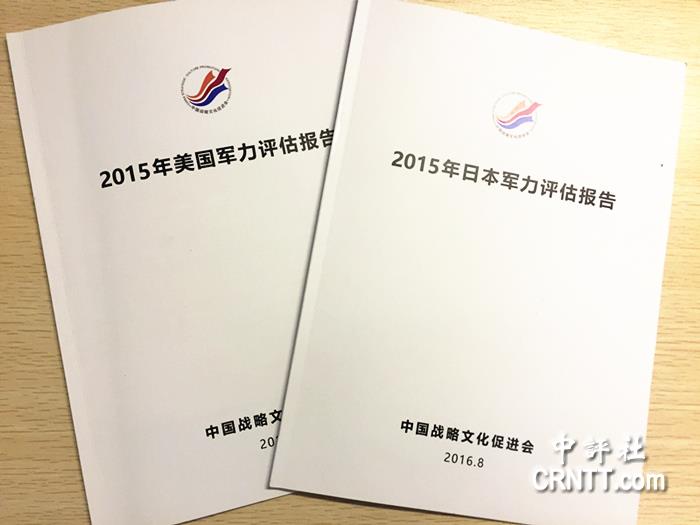
|
| 中文版《2015年美國軍力評估報告》和《2015年日本軍力評估報告》(中評社圖片) |
中評社北京8月15日電(記者 徐夢溪 實習記者 方一優)《2015年日本軍力評估報告》由中國戰略文化協會發布,由中國社科院美國所和日本所參與撰寫。以下為報告英文版全文。
Japanese Military Power 2015
Chapter I Overall Policy Adjustments
The year of 2015 marked a phased conclusion to the Abe Administration’s unrelenting promotion of significant adjustments and changes in Japan’s security domain. Since Mr. Abe took office for a second time in December, 2014, from the introduction of National Security Strategy and the new National Defense Programme Guidelines in 2013, through partially lifting the ban both on arms exports and on collective self-defense, to the revision of the Guidelines for Japan-U.S. Defense Cooperation, the passage of “Security Bills” in 2015, the comprehensive policy adjustments of security and defense (also called “Abe national defense”, including all the elements of relevant laws, decision-making process, system, equipment, deployment and so on) guided by the Abe Administration have temporarily come to an end. In other words, through “the three consecutive policy breakthroughs” after Abe took office again, the macro adjustments of Japan’s security policies, highlighted by the pass of the new Security Bills have reached a temporary conclusion, marking Japan’s “defense normalization” and “major military power status” henceforth have entered a new phase and taken on a new look. That is to say, since 2015, Japan’s measures in the security field, which mainly revolved mainly around operational aspects such as law enforcement, strategy execution and policy implementation, rather than drastic adjustments and changes in framework, mechanism and policy.
In 2015, in Japan’s security and defense, the most significant comprehensive policy adjustments were:the revision of the Guidelines for Japan-U.S. Defense Cooperation in April after an interval of 18years; the Diet’s final approval of the new security bills in September.
In April, U.S. and Japan completed the revision of the Guidelines for Japan-U.S. Defense Cooperation, an organic part of Japan’s efforts to seek “defense normalization” and to assist the U.S. with its strategic rebalance towards Asia and the Pacific. The revision further enhances the U.S.-Japan alliance, allows Japan to further build up its military capabilities and send JSDF overseas for engagement in international security affairs within the framework of the U.S.-Japan alliance, revealing the intention of closer Japan-US alliance to contain the rise of China. Specifically, the revised guidelines require that:firstly, U.S. and Japan would enhance the roles and tasks that each should play and undertake so as to improve cooperation and interoperability between them; secondly, U.S. and Japan would carry out “seamless reaction” to “ensure Japan’s peace and security”; in the name of “collective self-defense”, Japan would seek military buildup with an intention to play a greater military role; thirdly, the U.S. and Japan would intervene more extensively and forcefully in both regional and global security affairs; fourthly, U.S. and Japan would work together to meet the maritime, space and cyber challenges.
In September, Japan formally passed the new package of security bills which is composed of Japan’s Legislation for Peace and Security and International Peace Support Bill. The former, which was integrated through amendments to the Japan Self-Defense Forces Act, The Law Regarding the Response to Armed Attacks, International Peace Cooperation Law, Perimeter Situation Law, specifying what the JSDF could do in terms of collective security and providing logistic support for other countries in time of crisis concerning the survival of the nation and other significant matters, and the conditions under which JSDF is allowed to expand the range of PKOs and to use arms. The latter, which was in essence a “permanent law for deploying troops overseas”, stipulating that JSDF set out for overseas missions and provide cooperative support for other countries whenever possible in “matters affecting international peace”. The new security bills were considered by the Japanese authorities as pivotal to optimize the foundations of its security assurance, and as a result, the year 2015 was regarded as “the first year of security assurance”.
Henceforth, in theory, as long as the Japanese government finds “legal” excuses, it can make the following three breakthroughs on a limited basis in security policies:worldwide engagement in collective self-defense through collaborations with the U.S. and other countries; sending troops overseas at any time to offer logistic support to the U.S. and other countries; expanding engagement ranges and permissions to the use of arms in international peacekeeping operations.
According to the Japanese government, in the new situations, as there were some defects in the old security bills, for example, inadequate coverage and the lack of connections, the bills needed to be improved and optimized so as to provide a legal ground for seamless responses to various events on the two dimensions of time (various events) and space (national, peripheral and regional, and international). Through the three breakthroughs, the Abe Cabinet attempted to accomplish its manifold goals, such as “state normalization”, sending JDFS overseas for engagement in international security affairs, enhancement of U.S.-Japan alliances, defense against China and containment of China.
|